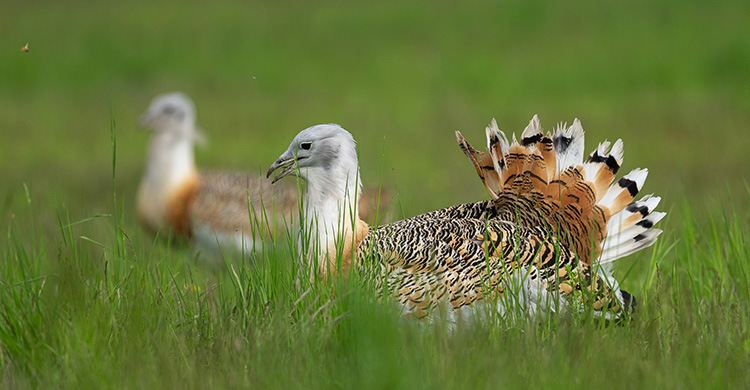New Conservation Action Agreed for the King of the Steppe

Great Bustard © Franz Josef Kovacs
Bratislava, 21 September 2023 – At the Fifth Meeting of Signatories (MOS5) of the Memorandum of Understanding on the Conservation and Management of the Middle-European Population of the Great Bustard (Otis tarda), delegates from the 14 Signatory States and Cooperating Organizations agreed on transboundary conservation measures for the Great Bustard. The measures agreed in Bratislava aim to improve the conservation status of this iconic species, the ‘King of the Steppe’, which inhabits the open plains of Europe and Asia.
“The Great Bustard is the largest flying bird in Europe and a flagship species for the protection and promotion of open European landscapes. Yet, this CMS-listed species is also Globally Threatened and has been undergoing severe population declines in many parts of its range,” said Amy Fraenkel, Executive Secretary of the Convention on the Conservation of Migratory Species of Wild Animals (CMS).
The Great Bustard is listed in CMS Appendix I and II, and the central European population is the only one that is stable, as the species is suffering from drastic declines in its range, particularly in Asia.
Intensive agriculture and infrastructure projects have been the main cause of the decline of Great Bustard populations. Barriers such as afforested areas, shelter belts, railways, roads and fences tend to fragment their habitats. The Great Bustard’s tendency to make low and short-distance flights makes it difficult for the birds to avoid such hazards, while the construction of new highways and railways pose further risks of fatal injuries. Many birds are known to collide with power lines, which is considered one of the most significant causes of mortality in bustard species worldwide.

In the face of the population decline especially in Asia, and with only 29,000 to 33,000 individuals remaining globally, the species will likely be proposed for uplisting to the category ‘Endangered’ on the IUCN Red List in 2024.
The intergovernmental conference was preceded by a Scientific Symposium, during which experts discussed the current status of the Great Bustard population in central-south-eastern Europe, identified the main threats, and suggested prioritized conservation and management actions.
Based on these inputs, the MOS5 meeting took stock of the status of the species and the implementation of the MOU Action Plan and the affiliated Medium-Term International Work Programme. In addition, the meeting agreed on a number of measures which will help to improve the future conservation status of the Great Bustard, including:
- A Medium-Term International Work Programme for the period 2023-2028, which re-prioritized the key actions needed as well as proposed new ones, such as: adapting management measures to the most recent agricultural practices; changing crop structures in agricultural landscapes e.g. due to irrigation patterns; using GPS-tracking to support habitat and survival analyses; identifying precise habitat and flyways maps to model the most suitable areas for Great Bustards; increased awareness raising to foster better understanding of the threats posed by avian influenza and climate change or the need for harmonized national restoration plans for the Great Bustard;
- An update of the MOU’s Action Plan according to re-prioritized and adjusted actions;
- A new set of guidelines on measures to secure successful wintering of Great Bustards, predator management, and agri-environmental schemes which will benefit of Great Bustards.
“We welcome the work being done by the Signatories of the CMS Great Bustard MOU to halt and reverse the decline of this species. The inclusive conservation and management efforts involving all local stakeholders are a great conservation success story and a model for others to follow,” said Fraenkel.
MOS5 was generously hosted and organized by the Ministry of Environment of the Slovak Republic and the State Nature Conservancy of Slovakia, with support from both Government representatives and partner organizations from Austria, Hungary and Germany, as well as the LIFE Great Bustard Project and the LIFE Steppe on Border Project.
At the end of the meeting, the Austrian delegation announced the intention to host the next meeting of the Signatories of the Great Bustard MOU which will likely take place in 2028.
Last updated on 27 September 2023








